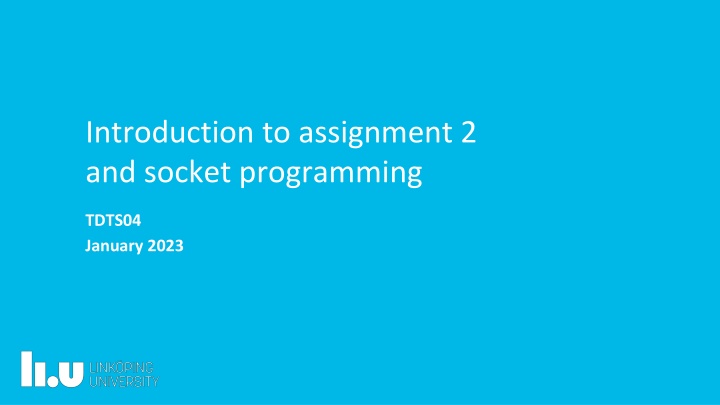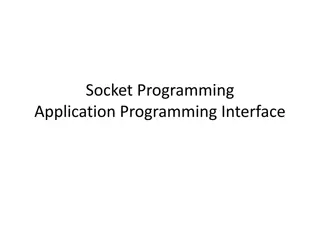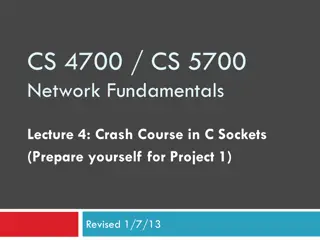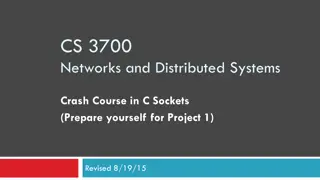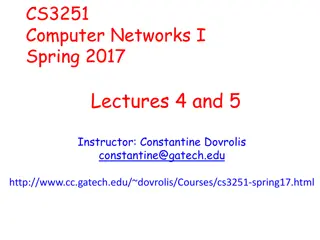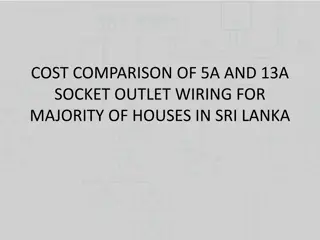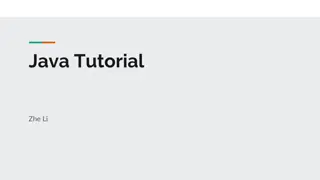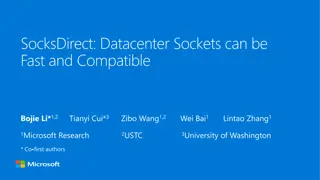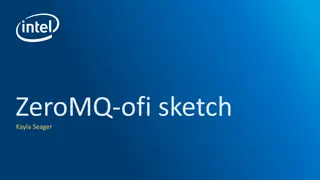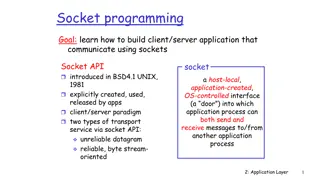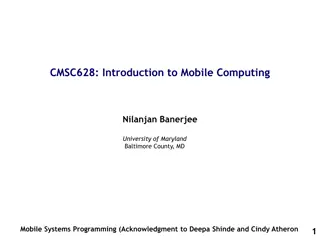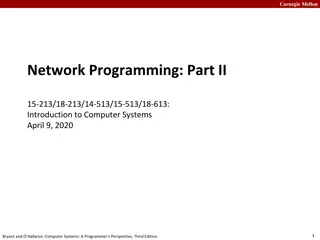Introduction to Socket Programming for Assignment 2
This content provides an overview of the upcoming Assignment 2 on socket programming for the TDTS04 course in January 2023. It covers topics such as HTTP, Proxy, WWW, and HTTP Server, along with general assignment information and deadlines. The content also explores the concepts of World Wide Web (WWW), HTTP protocol, and TCP/IP socket programming. Additionally, it discusses the application of HTTP in transferring HTML pages and embedded objects in a client-server paradigm. Further reading suggestions are provided for a deeper understanding of the subject.
Download Presentation

Please find below an Image/Link to download the presentation.
The content on the website is provided AS IS for your information and personal use only. It may not be sold, licensed, or shared on other websites without obtaining consent from the author.If you encounter any issues during the download, it is possible that the publisher has removed the file from their server.
You are allowed to download the files provided on this website for personal or commercial use, subject to the condition that they are used lawfully. All files are the property of their respective owners.
The content on the website is provided AS IS for your information and personal use only. It may not be sold, licensed, or shared on other websites without obtaining consent from the author.
E N D
Presentation Transcript
Introduction to assignment 2 and socket programming TDTS04 January 2023
2 TDTS04 Introduction to lab 2 & socket programming Lecture outline General lab assignment information Assignment 2 HTTP & Proxy Socket programming Questions
3 TDTS04 Introduction to lab 2 & socket programming General lab assignment information Assignment 1 should be finished as soon as possible Assignment 2 takes time, and have a soft deadline due the 14thof Feb. Third assignment is more in the style of the first and shouldn t take too much time The last assignment (4) needs a little more time so don t put it off Semi-hard deadline and last time to demonstrate easily is March 14 or the last date your lab group has scheduled Check with the TA if you plan to use languages other than those prescribed
4 TDTS04 Introduction to lab 2 & socket programming Assignment 2 what will we do? Learn about WWW and HTTP Learn TCP/IP socket programming to understand HTTP and WWW better Build a simple proxy
5 TDTS04 Introduction to lab 2 & socket programming What is WWW? It is a world-wide system of interconnected servers which distribute a special type of document. Documents are marked-up to indicate formatting (Hypertexts) This idea has been extended to embed multimedia and other content within the marked-up page.
6 TDTS04 Introduction to lab 2 & socket programming What is HTTP? HTTP is WWW's application layer protocol HyperText Transfer Protocol (HTTP) to transfer HyperText Markup Language (HTML) pages and embedded objects Works on a client-server paradigm Needs reliable transport mechanism (TCP) For further reading: Kurose, James F. & Ross, Keith W. Computer Networking: A Top-Down Approach, 8th Edition (2020), Pearson Education Chapter 2 Section 2.2
7 TDTS04 Introduction to lab 2 & socket programming HTTP Server Router Client
8 TDTS04 Introduction to lab 2 & socket programming HTTP Note: HTTP server always runs on port 80 Server Router Client
9 TDTS04 Introduction to lab 2 & socket programming HTTP Note: HTTP server always runs on port 80 Note: Client can use any unrestricted port Generally >1024 Server Router Client
10 TDTS04 Introduction to lab 2 & socket programming Proxy Acts as intermediary between client and server.
11 TDTS04 Introduction to lab 2 & socket programming Benefits of a proxy Hide your internal network information (such as host names and IP addresses) You can set the proxy to require user authentication The proxy provides advanced logging capabilities Proxy helps you control which services users can access Proxy-caches can be used to save bandwidth
12 TDTS04 Introduction to lab 2 & socket programming HTTP with proxy Note: HTTP server always runs on port 80 Proxy listens on a port (>1024) and talks to server on another (>1024) Server Note: Client can use any unrestricted port Generally >1024 Router Proxy Client
13 TDTS04 Introduction to lab 2 & socket programming What is a port? A port is an application-specific or process-specific software construct serving as a communications endpoint The purpose of ports is to uniquely identify different applications or processes running on a single computer and thereby enable them to share a single physical connection to a packet-switched network like the Internet
14 TDTS04 Introduction to lab 2 & socket programming Ports continued Port only identifies processes/applications With regard to the Internet, ports are always used together with IP Notation 192.168.1.1:80 IP address Transport protocol port UDP/TCP
15 TDTS04 Introduction to lab 2 & socket programming Socket programming These are software constructs used to create ports and perform operations on them We will talk about these types of sockets: Datagram socket Stream socket SSL sockets
16 TDTS04 Introduction to lab 2 & socket programming Datagram sockets Datagram sockets use UDP They are connectionless Do not guarantee in order delivery No form of loss recovery No congestion control No flow control
17 TDTS04 Introduction to lab 2 & socket programming Stream sockets Stream sockets use TCP protocol Connection oriented sockets In order and guaranteed delivery Error identification and recovery Congestion control Flow control SSL sockets are similar to stream sockets, but include functions to handle encryption
18 TDTS04 Introduction to lab 2 & socket programming Important socket calls socket bind listen accept connect send recv
19 TDTS04 Introduction to lab 2 & socket programming Socket programming calls socket() Takes as input Address family (=AF_INET) Socket type (=SOCK_STREAM) Returns A socket object
20 TDTS04 Introduction to lab 2 & socket programming Socket programming calls bind() Takes as input address/port tuple (for AF_INET) What does this do? Associate the socket with an address/port tuple
21 TDTS04 Introduction to lab 2 & socket programming Socket programming calls listen() Takes as input Backlog (max queue of incoming connection) This must run at the server side to listen to incoming connection
22 TDTS04 Introduction to lab 2 & socket programming Socket programming calls connect() Takes as input Address/port tuple What does this do? Attempts to setup a connection with the other end
23 TDTS04 Introduction to lab 2 & socket programming Socket programming calls accept() input Returns conn - a new socket object address - address/port tuple Reads through the backlog and picks one from the list to connect to it. Runs at the server side
24 TDTS04 Introduction to lab 2 & socket programming Socket programming calls send() Takes as input Message Returns Number of bytes sent Send is always best effort. If it cannot send the whole message, the returned value is smaller.
25 TDTS04 Introduction to lab 2 & socket programming Socket programming calls recv() Takes as input Max buffer length Returns bytes object representing the data received
26 TDTS04 Introduction to lab 2 & socket programming Socket programming calls close() No input Marks the socket as closed
27 TDTS04 Introduction to lab 2 & socket programming Socket programming resource Helpful guide linked from the assignment text: Beej s Guide to Network Programming Based on C, but can be used as a foundation for other languages
28 TDTS04 Introduction to lab 2 & socket programming Assignment 2: Simple Web (HTTP) proxy Build a properly functioning Web proxy for simple Web pages, and then use your proxy to change some of the content before it is delivered to the browse Change all occurrences of "Smiley" on a Web page into "Trolly", and all occurrences of "Stockholm" into "Link ping". And if you find any JPG images of Smiley (linked or embedded), then you should replace them with your favorite troll image file (JPG, GIF, or PNG) from the Internet. For the sake of simplicity, we will restrict ourselves only to HTTP (not HTTPS), and consider only basic text and HTML pages with a few images.
29 TDTS04 Introduction to lab 2 & socket programming Assignment 2: description Socket programming is the key Build a proxy to which a user can connect to The proxy connects to the web server on user's behalf (recollect how proxy works) Proxy receives the response from the web server Proxy forwards the HTTP response (from the web server) to the user with all occurrences of "Smiley" replaced by "Trolly", and all occurrences of "Stockholm" replaced by "Link ping"
30 TDTS04 Introduction to lab 2 & socket programming Assignment 2: requirements 1. The proxy should support both HTTP/1.0 and HTTP/1.1. 2. Handles simple HTTP GET interactions between client and server 3. Consider how your proxy handles commonly occurring HTTP response codes, such as 200 (OK), 304 (Not Modified), and 404 (Not Found) 4. Imposes no limit on the size of the transferred HTTP data 5. Use only the basic libraries available for socket programming Check with TA
31 TDTS04 Introduction to lab 2 & socket programming Assignment 2 requirements 6. Is compatible with all major browsers (e.g. Internet Explorer, Mozilla Firefox, Google Chrome, etc.) without the requirement to tweak any advanced feature 7. Allows the user to select the proxy port (i.e. the port number should not be hard coded) 8.Is smart in selection of what HTTP content should be searched for the forbidden keywords. For example, you probably agree that it is not wise to search inside compressed or other non-text-based HTTP content such as graphic files, etc. 9. You do not have to relay HTTPS requests through the proxy
32 TDTS04 Introduction to lab 2 & socket programming Browser configuration Proxy listens on a particular port 127.0.0.1 Proxy's port number Make sure it is blank
33 TDTS04 Introduction to lab 2 & socket programming HTTP basics Recollect lab 1. It contains things what you need in lab 2. HTTP request Get Syn, Syn-Ack, Ack
34 TDTS04 Introduction to lab 2 & socket programming HTTP basics HTTP response OK
35 TDTS04 Introduction to lab 2 & socket programming HTTP basics HTTP 1.0 vs HTTP 1.1 Read about differences For this assignment Connection: close Handshake-Get-response-OK-Teardown Connection: keep-alive Handshake-Get-response-OK-wait-Get-response What should you use for the proxy?
36 TDTS04 Introduction to lab 2 & socket programming How to handle connections With connection: keep-alive, the connection is kept open. You are responsible to figure out when the response is completed. With connection: close, the server closes the connection after the response is sent. How can you enforce connection: close on HTTP 1.1?
37 TDTS04 Introduction to lab 2 & socket programming General overlay Server Client side Server side Proxy Client
38 TDTS04 Introduction to lab 2 & socket programming General overlay Server side: listens on a port, accepts, receives, forwards to client side Server Client side Server side Proxy Client
39 TDTS04 Introduction to lab 2 & socket programming General overlay Client side: connects to the server, send request, receive response, Forwards to server side Server Client side Server side Proxy Client
40 TDTS04 Introduction to lab 2 & socket programming Content filtering Need to be able to filter both based on URL and content In which of the two halves of the proxy will you implement filtering based on URL? In which of the two halves of the proxy will you implement content filtering? How to actually do content filtering?
41 TDTS04 Introduction to lab 2 & socket programming Content filtering Response from the server comes in segments Remember TCP segmentation? Reconstruct the message in a temporary buffer No dynamic sizing of buffer, chose a value and stick with it Do not type-cast non-text data! Then run filtering only on the text message
42 TDTS04 Introduction to lab 2 & socket programming Text vs binary data Content-type header Differentiate content type Run/don't run filtering
43 TDTS04 Introduction to lab 2 & socket programming Debugging advice Stick to simple web pages initially Debug incrementally Check and double check request string for formatting and completeness Source of many errors like 'server closed connection unexpectedly' If developing on own computers, use Wireshark to debug. Can save a lot of time!
44 TDTS04 Introduction to lab 2 & socket programming Debugging advice HTTP vs HTTPS Requirements do not ask for a proxy which works with HTTPS Avoid testing on any site to which you are signed in Restrict yourselves to simple sites and basic test cases
45 TDTS04 Introduction to lab 2 & socket programming Debugging advice Header manipulation First thing to check at a proxy is the URL that it sends out to the server It might require different manipulations based on the site. Be sure that you test for all sites mentioned in the test scenario If you change some fields in the header, the packet length has to be changed or brought back to the original length
Questions? e-mail your TA (subject TDTS04 ) www.liu.se
